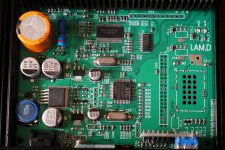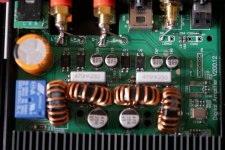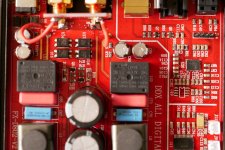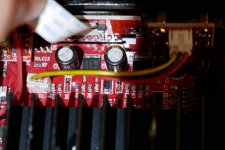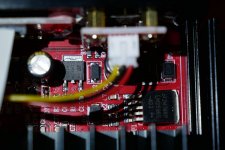well, you used the word upgrade 🙂 if you have Oreo? A bt5 compatible phone? Know how to disable absolute volume, set sample rate..? And a ******* huge antenna to compensate for radio parts that can't handle the higher data rate? Honestly, the 8675 is ****. There I said it. Wait for something better imo. Or buy an FX Audio D2160 and upgrade everything at once 🙂Don't assume that I'm not well aware that there may be issues...
Last edited:
Has anyone done a comparison of the FXAudio d802 to the FXAudio 502SPro? I have two of 502SPro and think they sound terrific for the price. Has anyone heard both and can enlighten me to the sound differences? Thank you!
Ha ha how true. I don't use Bluetooth as it is again compression. Convenience is nice but quality is more important.
Haha... surely agree with you. The "highest truth" of all is known as advertisements
"CSR8675 is a premium tier single-chip solution delivering high quality wireless audio performance and supporting the development of highly differentiated premium wireless audio products. Integrated support for aptX, aptX HD, Active Noise Cancellation and TrueWireless stereo.
AptX™ HD audio ensures your Bluetooth® wireless enabled device can deliver High Definition (HD) audio. It preserves sound data through the audio transmission, resulting in a ‘better-than-CD’ listening experience.
With aptX HD, you can enjoy listening to your music at the highest audible quality when using a wireless device.
aptX HD is indistinguishable from high resolution audio
aptX HD enables 24-bit music quality over a Bluetooth® wireless connection"
Copyrighted -- by some company.😀
Last edited:
Mastering for vinyl also uses compression... 😉
What Mastering ?
"Both DSD and PCM are “quantized,” meaning numeric values are set to approximate the analog signal. "
I rather have DSD - more honest in representing themselves.
Attachments
Hi all,
I got a V200 (Version 12) and D802 (Version 2 11/11/2017) and plan to upgrade the D802 first since it will the easiest do I think - regulators, tcxo, maybe add a bluetooth and an output for a subwoofer.
Does anyone know what caps C85 and C86 do in the D802? They are 16V 220uF - middle of pic 3. There's another pair like that on the left too.
Here's some pics. At the moment, the D802 v2 has a better soundstage than the V200 v12 but the the V200 looks like it has more potential for improvement.
I got a V200 (Version 12) and D802 (Version 2 11/11/2017) and plan to upgrade the D802 first since it will the easiest do I think - regulators, tcxo, maybe add a bluetooth and an output for a subwoofer.
Does anyone know what caps C85 and C86 do in the D802? They are 16V 220uF - middle of pic 3. There's another pair like that on the left too.
Here's some pics. At the moment, the D802 v2 has a better soundstage than the V200 v12 but the the V200 looks like it has more potential for improvement.
Attachments
Last edited:
Hugh Jazz, could not believe but I see again sendust ring cores in class D amp which suppose to be called HiFi? Tell me that I'm wrong due to unclear picture and core material is not sendust, please! I used sendust cores ONLY with subwoofers class D and only with lots of loop gain of fb taken after thse coils. If there really sendust, it is number one contender for a tweak for sure ))
marking makes difference but I never have seen black coated core material#2 which is good for linearity, black coated core with white marking always chinese sendust or korean sendust in the best case.
It seems from the pics I took that they are wired as super e caps (in series, neg to neg) with 2x 1K resistors to ground. This would provide a high pass of 2K with a corner frequency of 0.7Hz. So, a dummy load, on one pole of the relay? Or...? It seems likely - I guess diodes U14-U17 are there to protect the amp's outputs on the other pole which connects to the speaker terminals...Does anyone know what caps C85 and C86 do in the D802? They are 16V 220uF - middle of pic 3. There's another pair like that on the left too.
Last edited:
Hugh Jazz, could you please take a better picture of those black core marking? I wondered if there really sendust instead of micrometals #2.
Sure, next time I open it up... I have a few things to investigate for the V200 v12 - there are so many empty pin outs but with the smd components there, ready for an IC. For example, the pin outs for the ADC (U22) match the PCM1803 which other versions have. Anyway, let you know about the coils when I get the chance to open it again 🙂
I need to open up the D802 again too - didn't get good enough pics of power routing. My earlier thought that each regulator fed the next lower voltage one seems to be wrong. It seems the LM2596 is 12V for the relays and it feeds two LM317, one for 5V and another for 3.3V. This has me thinking what is the 5V for? The CM6642? And can I re-wire them to get the benefit of combined ripple rejection? We shall see...
I need to open up the D802 again too - didn't get good enough pics of power routing. My earlier thought that each regulator fed the next lower voltage one seems to be wrong. It seems the LM2596 is 12V for the relays and it feeds two LM317, one for 5V and another for 3.3V. This has me thinking what is the 5V for? The CM6642? And can I re-wire them to get the benefit of combined ripple rejection? We shall see...
Last edited:
Hugh Jazz - I don't have a D802 yet, but from carefully flipping back and forth between pictures and following traces I'm pretty sure the 3.3V and 5V regulators are both fed separately from the LM2596. This is also supported by measurements Paulkouhan from homecinema took at the inputs of the LM317s - 11.5V for the 5V regulator and 10.8V for the 3.3V. The latter is lower due to a diode inline with the input. For protection I think?
It appears the 5V is used only for the board's mystery controller which I think is an STM8S005K6 or similar (ask me how I figured this out). The STA326 (digital section), AK4113, VIA1630A and the clock all seem to use 3.3V. Unfortunately I don't have any detailed pictures of a board that uses a CM6642.
It appears the 5V is used only for the board's mystery controller which I think is an STM8S005K6 or similar (ask me how I figured this out). The STA326 (digital section), AK4113, VIA1630A and the clock all seem to use 3.3V. Unfortunately I don't have any detailed pictures of a board that uses a CM6642.
Thanks ! I found that thread here <<Tweak fx802>> - 30079404 - sur le forum <<Amplis et Preamplis>> - 1056 - du site Homecinema-fr.com
His suggested tweaks are somewhat similar to my plan... 🙂 I plan to modify the LM2596 for a higher voltage and disconnect its output inductor so I can feed the output of the LM2596 through a better LCLC filter and into an LT3045 which should remove over 70dB of the switching noise to provide a much cleaner 12V. I notice that the implementation of the LM2596 in V2 is changed over V1 (adj vs fixed and better layout it seems) so I'll check to make sure its layout has been done to stop noise contamination. Jean-paul says 100mV for LM2596 https://www.diyaudio.com/forums/cla...d802-optimisation-tpa3116-33.html#post4798922 and that seems about right - it can be reduced with better output filtering, but even so, with 70dB reduction, a factor of about 3000, it should be 30uV or so. Then replace the LM317 with TPS7a or LT3045 and they should be able to hit their noise floor if the LM2596 is not contaminating ground. If it is, then I may need to fit one that has its own PCB.
His suggested tweaks are somewhat similar to my plan... 🙂 I plan to modify the LM2596 for a higher voltage and disconnect its output inductor so I can feed the output of the LM2596 through a better LCLC filter and into an LT3045 which should remove over 70dB of the switching noise to provide a much cleaner 12V. I notice that the implementation of the LM2596 in V2 is changed over V1 (adj vs fixed and better layout it seems) so I'll check to make sure its layout has been done to stop noise contamination. Jean-paul says 100mV for LM2596 https://www.diyaudio.com/forums/cla...d802-optimisation-tpa3116-33.html#post4798922 and that seems about right - it can be reduced with better output filtering, but even so, with 70dB reduction, a factor of about 3000, it should be 30uV or so. Then replace the LM317 with TPS7a or LT3045 and they should be able to hit their noise floor if the LM2596 is not contaminating ground. If it is, then I may need to fit one that has its own PCB.
Last edited:
The LM2596 is the weakest point. I replaced if for a ready built SMPS module and that was a large difference. Meanwhile I sold the D802 and ended up with a Denon PMA50 which does not have all the issues related with the cheap chinese amps. Add all costs up and the costs are higher than a single PMA50.
Many buy more cheap FDA than just D802 as you can read. PMA50 can be found cheaper. Don’t forget the import taxes on the Chinese amps.
Cheap + cheap + cheap = ....
Cheap + cheap + cheap = ....
Last edited:
The LM2596 is the weakest point. I replaced if for a ready built SMPS module and that was a large difference.
Yep, for sure, and it has just 33uH after it in the D802 - Webench says a 470uH 800mR inductor with a 1000uF 1000mR cap will significantly reduce noise to levels more like a 7812. I've seen someone else do this on a similar STA326 amp using a 1mH inductor IIRC ... can't find that post though. My main concern is whether the LM will be messing up the ground. I gather the best test for this is to have a signal lock in the amp but no volume in the source with the amp volume fully cranked up. This way the auto mute doesn't mask the background noise.
- Home
- Amplifiers
- Class D
- I AM D v200, Fx Audio d802, optimisation and TPA3116
